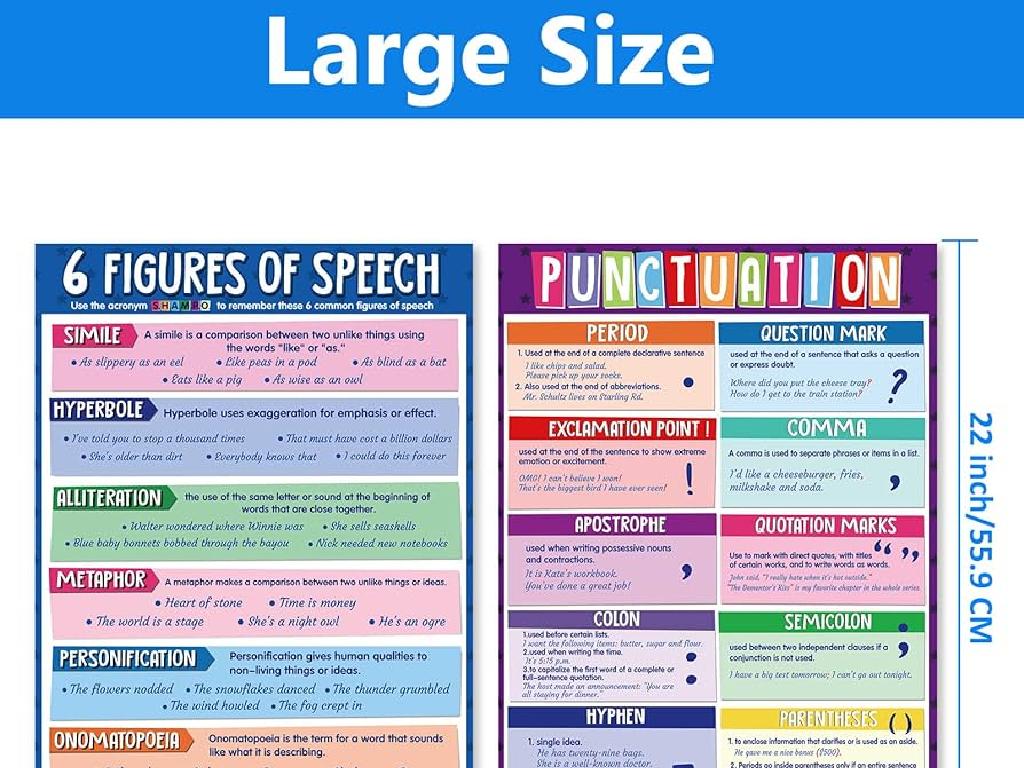Industrialization
Subject: Arts and humanities
Grade: High school
Topic: World History Project - 1750 To The Present
Please LOG IN to download the presentation. Access is available to registered users only.
View More Content
The Dawn of Industrialization
– Exploring the Industrial Revolution
– A period of major industrial and social change beginning in the late 18th century.
– Societal changes post-1750
– Shift from agrarian, handcraft to industrial, factory-based economies.
– Global impacts of Industrialization
– Influenced urbanization, labor systems, and global trade patterns.
– Previewing Industrialization’s legacy
– A glimpse into how Industrialization shaped modern society and its ongoing effects.
|
This slide introduces students to the concept of Industrialization, starting with the Industrial Revolution. It’s crucial to convey the magnitude of change that began in the mid-18th century, transforming economies, societies, and global interactions. Discuss the shift from rural to urban living, the rise of factories, and the new class of industrial workers. Highlight how these changes led to increased production and a shift in global trade. Use this opportunity to set the stage for a deeper dive into the profound and lasting impacts of Industrialization on the world, which will be covered in subsequent lessons.
The Birth of Industry
– Transition to industrial economies
– Shift from farm work to manufacturing jobs
– Invention of the steam engine
– Steam engine powered machines, revolutionizing production
– Emergence of factories
– Factories centralized production, altering labor
– Rise of the working class
– New social class of factory workers, distinct from farmers and artisans
|
This slide introduces the pivotal shift from agrarian societies to industrial economies, marking the beginning of the Industrial Revolution. Highlight the role of the steam engine as a cornerstone invention that enabled mass production and the growth of industries. Discuss how the emergence of factories centralized production and led to the development of urban areas. Emphasize the formation of a new working class, which brought about significant social and economic changes. This transformation laid the groundwork for modern economies and is crucial for understanding the subsequent evolution of society and industry.
Technological Advancements During Industrialization
– Inventions spurring industrial growth
– Steam engine, telegraph, and assembly line were pivotal.
– Impact of the cotton gin and spinning jenny
– Cotton gin increased cotton processing speed, spinning jenny multiplied thread production.
– Locomotive’s role in industry
– Locomotives revolutionized transport, expanding markets.
– Technology’s effect on production and labor
– Machines improved efficiency but also altered workforce needs.
|
This slide aims to highlight the significant technological advancements that were instrumental in the Industrial Revolution. Key inventions like the steam engine, telegraph, and assembly line dramatically increased the scale and speed of production. The cotton gin and spinning jenny specifically revolutionized the textile industry by vastly improving the efficiency of cotton processing and thread production. The advent of the locomotive opened up new markets by facilitating faster and more extensive transportation of goods. Overall, these technologies not only increased production but also fundamentally changed the nature of labor, leading to shifts in the workforce and the rise of factory work. Discuss the broader implications of these changes on society and the economy, and encourage students to consider both the positive and negative effects of industrialization.
Social and Economic Impact of Industrialization
– Shift in social structures
– Emergence of a middle class due to new industrial jobs.
– Rise of capitalism and trade
– Capitalism grew as industries expanded, increasing trade.
– Urbanization and living conditions
– Cities grew rapidly, often leading to overcrowded housing.
– Global market emergence
– Industrialization linked economies, creating a worldwide market.
|
This slide examines the profound social and economic transformations brought about by industrialization. The creation of new industrial jobs led to the emergence of a middle class, which altered the existing social hierarchy. Economically, capitalism became the dominant force, with trade flourishing alongside the growth of industries. Urbanization, a direct result of industrial job concentration, often resulted in poor living conditions due to rapid and unplanned city growth. Lastly, the global market emerged as nations became economically interdependent, with goods and capital flowing across borders more freely. Discuss how these changes laid the groundwork for modern society and the issues that arose, such as class struggle and the need for social reforms.
Industrialization’s Global Influence
– Spread from Britain globally
– Industrialization began in Britain and expanded through Europe, North America, and beyond.
– Colonialism’s role in resource extraction
– Colonies provided raw materials for European factories, fueling industrial growth.
– Formation of global economic networks
– Trade and investment linked countries, creating interdependent economic relationships.
– Division of labor worldwide
– Specialization and trade led to a global division of labor, shaping modern economies.
|
This slide explores the expansion of industrialization from its origins in Britain to a global phenomenon, reshaping economies and societies worldwide. It highlights the role of colonialism in providing the raw materials necessary for industrial growth and how this led to the exploitation of colonies. The creation of global economic networks facilitated the spread of industrialization, with capital flowing from industrialized nations to less developed regions, establishing a global market. The division of labor, both within and between countries, became more pronounced, with some regions specializing in raw material extraction and others in manufacturing. Discuss the impacts of these developments on different regions and classes, and how they laid the groundwork for the modern global economy.
Environmental and Cultural Effects of Industrialization
– Impact of mass production
– Factories and pollution altered landscapes and ecosystems.
– Cultural shifts in art and literature
– Industrial themes in art and the rise of realism in literature.
– The Luddite movement
– Workers’ rebellion against machinery that threatened their jobs.
– Romanticism’s response
– Emphasized emotions and nature as a reaction to industrialization.
|
This slide examines the profound environmental and cultural changes brought about by industrialization. The advent of mass production led to significant environmental degradation, with factories contributing to pollution and altering natural landscapes. Culturally, this period saw a shift in artistic and literary expression, with art reflecting the new industrial landscape and literature exploring themes of industrial life. The Luddite movement represents the social upheaval of the time, with workers destroying machinery that they believed threatened their livelihoods. Romanticism, as a cultural movement, arose in part as a critique of the industrial age, emphasizing the importance of emotion, individualism, and the beauty of the natural world. Encourage students to consider how these historical responses to industrialization have parallels in today’s society, particularly in discussions about technology and the environment.
Industrialization in the Modern World
– Legacy of past industrialization
– How the Industrial Revolution shaped today’s society, economy, and technology.
– The Fourth Industrial Revolution
– The ongoing technological revolution that is blurring the lines between physical, digital, and biological spheres.
– Digital transformation’s impact
– How digitalization is changing the way we work, live, and relate to one another.
– Industry and sustainability
– The importance of balancing industrial growth with environmental and social responsibility.
|
This slide aims to connect the historical concept of industrialization with its modern implications. Begin by discussing the lasting effects of the Industrial Revolution, such as urbanization and the rise of manufacturing economies. Transition to the Fourth Industrial Revolution, characterized by a fusion of technologies and a significant shift in industry and daily life. Highlight the role of digital transformation in shaping current industrial practices and the workforce. Finally, address the critical issue of sustainability, emphasizing the need for industries to adopt environmentally friendly practices and contribute to a sustainable future. Encourage students to think critically about how the lessons of past industrialization can inform current and future practices.
Class Activity: Industrialization Debate
– Divide into groups for debate
– Represent different societal roles
– Roles like factory worker, business owner, or farmer
– Debate pros and cons of Industrialization
– Discuss benefits like economic growth and challenges like labor conditions
– Reflect on Industrialization’s impact
– How has Industrialization influenced today’s society and technology?
|
This activity is designed to engage students in a debate that will help them understand the multifaceted impact of Industrialization during the Industrial Revolution. By assuming roles of different societal members, students will explore diverse perspectives and the complex interplay between economic, social, and technological changes. The debate should highlight both the positive aspects, such as technological advancements and increased production, and the negative aspects, such as poor working conditions and social inequality. After the debate, guide students to connect historical Industrialization with its lasting effects on modern society, encouraging them to consider both the progress made and the challenges that remain. Possible roles for the activity include factory workers, business owners, farmers, reformers, and government officials. This will foster a deeper understanding of historical events and their relevance to contemporary issues.






